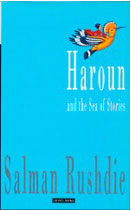|
REVIEW
After Salman Rushdie wrote The Satanic Verses (1988), the Ayatollah placed a fatwah upon him, causing Rushdie to adopt a life of seclusion and hiding. As a result, Rushdie suffered severe writer's block. Rushdie broke out of his slump in 1990 with Haroun and the Sea of Stories (1990), a children's book written as a means of explaining his situation to his son, largely through the use of allegory. Rushdie's experiences with censorship appear in the novel under the guise of the Old Zone section of the Sea of Stories and the division between the Guppees and the Chupwalas. Rushdie himself also appears allegorically in many characters of the book, namely Rashid, Princess Batcheat, Prince Bolo, and even Haroun. With this allegorical approach, Rushdie proposes his own beliefs about his situation and those responsible for censorship, while subtly poking fun at himself and his relation to the larger picture. Ultimately, though, Rushdie writes the novel not so much with the importance of his own situation at mind, as with the larger question of censorship. Thus, the novel stands not only as a personal testament for Rushdie's son, but also as a document universally opposing the oppression of writers.
Rushdie's allegorical representation of the censorship that plagues his life stands as the most discernible motif in the novel. The Sea of Stories lies upon the second of the earth�s moons, Kahani, which has been divided mechanically into two distinct hemispheres: "The Land of Gup is bathed in Endless Sunshine, while over in Chup it's always the middle of the night"(80). The Land of Gup takes care of the Sea of Stories with a rather socialistic hand, while the Chupwala, under the leadership of Khattam-Shud, wish to poison the sea and even remove language completely. Thus, those in the perpetual light propagate the stories and those in the perpetual darkness, adversely, strive to destroy, or censor, them. Here, on the surface, Rushdie seems to propose a purely polarized dispute between sides of complete good and complete evil, showing his displeasure with the censorship he has faced. The author, though, includes other passages which blur the line between freedom of speech and censorship, and blur the sides as well.
Rushdie subtly gives both sides of the Kahani moon traits which draw them closer to a median existence. The perpetual light/dark balance of the moon has been made possible, "Thanks to the genius of the Eggheads at P2C2E House"(80), which assigns a certain level of censorship to the Land of Gup. The Guppees have decided, without consent from the Chupwalas, that they will mechanically control the moon and subject the Chupwalas to permanent darkness. Thus, Rushdie seems to proclaim that some level of censorship, or at least the underlying desire to control that which one does not agree with, lies among just about everyone. Likewise, the Chupwala, apparently one dimensional, fight among themselves during the final battle and, "Many Chupwalas threw in their lot with the Guppees"(185). Many of the Chupwalas do not really want to be a part of Khattam-Shud's plans and seem to remain with his side purely out of fear. Most, like Mudra, the Shadow Warrior, do not wish to remain eternally silent. Moreover, when Rashid, Haroun, and the Guppees first encounter Mudra, the Shadow Warrior does attempt to speak to them. Mudra communicates with the Language of Gesture and, as Haroun watches him, "The dance of the Shadow Warrior showed him that silence had its own grace and beauty (just as speech could be graceless and ugly)"(125). Though the Chupwalas may communicate in different ways, Rushdie admits that their propositions are often worthwhile and even beautiful.
Here, Rushdie suggests that certain differences between groups are inherent and unavoidable. The actual fight, however, remains preposterous
|
